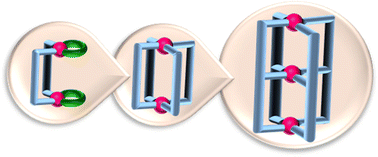Conjoined and non-conjoined coordination cages with palladium(ii) vertices: structural diversity, solution dynamics, and intermolecular interactions†
Abstract
Self-assembled coordination complexes prepared from a combination of Pd(II) components with one or more types of high-symmetry or low-symmetry bis/tris/tetrakis-monodentate ligands are considered in this review. The structures of these complexes are viewed in terms of the presence of a metallo-macromonocycle or conjoined metallo-macromonocycles/metallocages in the frameworks. Analysis of the typical molecular structures revealed an open truth that one or more units of metallo-macromonocycles can be conjoined to afford planar or non-planar systems. In the same line, the enveloping surface of a 3D cage can be considered as a multiple number of conjoined metallomacrocycles that embrace a 3D space from all directions. However, two or more units of cages are conjoined in a multi-3D-cavity cage system and such a system is considered as a conjoined cage. Construction of such conjoined cages having a finite but multiple number of 3D-cavities unified in a single molecular architecture is a challenging task when compared to that of single-3D-cavity based compounds. Conjoining of as many as four units of 3D cages is known so far. Single- as well as multi-cavity cages of lower symmetry have become a very recent trend in this regard where low-symmetry ligands or mixed ligand ensembles are crafted in the framework of the cages. Other structural diversities like helicity in cages, and supramolecular isomerism are also included in this assorted literature work. Although isomerism in classical coordination complexes is well known, it is very less studied in self-assembled coordination complexes. Ligand isomerism is one such feature that is reviewed here. The dynamic behavior of the cages results in interesting reactivity aspects. A large variety of dynamic processes are collected under an umbrella, i.e., “ligand exchange reactions” and described with examples. Intermolecular interaction among the already self-assembled molecules is possible in solution, solid, and gel-phases as discussed in the last part of this review. The understanding of intermolecular interaction is likely to influence different areas of research including crystal engineering, and materials chemistry.



 Please wait while we load your content...
Please wait while we load your content...